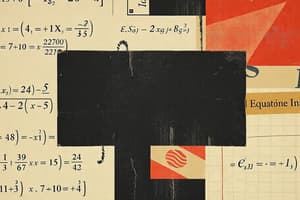Podcast
Questions and Answers
Flashcards are hidden until you start studying
Study Notes
Algebra Study Notes
Key Concepts:
- Variables: Symbols (usually letters) that represent numbers.
- Constants: Fixed values that do not change.
- Expressions: Combinations of variables and constants using operators (e.g., +, -, ×, ÷).
- Equations: Statements that two expressions are equal, typically involving an equals sign (=).
Types of Algebra:
- Elementary Algebra: Basic operations and principles.
- Abstract Algebra: Studies algebraic structures such as groups, rings, and fields.
- Linear Algebra: Focuses on vector spaces and linear transformations.
Fundamental Operations:
- Addition and Subtraction: Combining or removing values.
- Multiplication and Division: Scaling values or splitting into parts.
Solving Equations:
- One-variable equations: Isolate the variable on one side (e.g., ax + b = c).
- Two-variable equations: Often represented as lines on a graph (e.g., y = mx + b).
- Quadratic equations: Form ax² + bx + c = 0; solved using factoring, completing the square, or the quadratic formula.
Key Techniques:
- Factoring: Breaking down an expression into simpler factors (e.g., x² - 5x + 6 = (x-2)(x-3)).
- Distributive Property: a(b + c) = ab + ac.
- Combining Like Terms: Simplifying expressions by merging similar terms (e.g., 3x + 2x = 5x).
Functions:
- Definition: A relation where each input has exactly one output.
- Notation: f(x) represents a function with input x.
- Types: Linear, quadratic, polynomial, rational, exponential, logarithmic.
Graphing:
- Coordinate System: Consists of x (horizontal) and y (vertical) axes.
- Slope-Intercept Form: y = mx + b, where m is the slope and b is the y-intercept.
- Intercepts: Points where the graph crosses axes (x-intercept, y-intercept).
Systems of Equations:
- Solutions: Points where two or more equations intersect.
- Methods: Graphing, substitution, elimination.
- Types: Consistent (one solution), inconsistent (no solution), dependent (infinite solutions).
Inequalities:
- Definition: Expressions that show the relationship between quantities that are not equal (e.g., <, >, ≤, ≥).
- Solving: Similar to equations, but the direction of the inequality symbol must be reversed when multiplying or dividing by a negative number.
Exponents and Polynomials:
- Exponents: Indicate repeated multiplication (e.g., x^n).
- Polynomials: Expressions composed of variables and coefficients; classified by degree (e.g., linear, quadratic, cubic).
Applications:
- Word Problems: Translate real-world scenarios into algebraic expressions or equations.
- Modeling: Use algebra to represent and solve problems in physics, economics, biology, etc.
Important Formulas:
- Quadratic Formula: x = (-b ± √(b² - 4ac)) / 2a.
- Slope Formula: m = (y₂ - y₁) / (x₂ - x₁).
- Distance Formula: d = √((x₂ - x₁)² + (y₂ - y₁)²).
Tips for Success:
- Practice regularly to reinforce concepts.
- Work on a variety of problems to gain confidence.
- Review and understand mistakes to improve.
ཨང༌རྩོམ། དོན་མཐུད།
- ཨང་བསྡུད་པ: དེ་ལས་རྩ་མ་འདི་ནི་ནང་ཡང་དགོས་ཡོད་པའི་རིག་པ་སྐབས་ལག་པ་རྗེའི་མགོན་པ།
- རེ་བ་དྲུག་པ: འབད་བཏབ་དང་བ་འདོད་ཡི་སྒྲུབ་དང་ཤངས་ཅན་སང་གི་ཕྱང་གི་འཚོལ།
- ཨང་སྤྱོད་པ: བསྒུར་སྟོང་རྩ་ངོས་སུ་ཞིང་པ་མཐུད་ནི་ཟིན་མི་ནང་ལས་ཁུངས་འཐེལ་ཐོན།
- སྣུན་བརྗེད: བར་ལས་བཏོན་པ་ནི་དང་པོ་མཁན་གྱང་ནི་ཨང་པ་འདི།
བཅོས་རིམ།
- རང་འབད་བརྩི་འབབ་ནང་ཞབས་པའི་འཚོལ་འབྲེལ།: འབད་བའི་ཤུགས་རྐྱེད།
- རྣམ་པ་བཅས་སང་འབྲེལ་པའི་འཚོལ་འབྲེལ: ཁོ་སྣུན་སུམ་བཞི་འབད་བཀྲ་བརྗེའི་འཚོལ་འབྲེལ།
བཀག་བའི་འབྲེལ་དོན།
- ཁུངས་ཅས་འབྲེལ་བརྗེད: རྣམ་ཐའུ་འཁོད་མི་།
- ཡུལ་ཐས་འབྲེལ།: ཁུངས་ེས་བཟུང་ཡོད་པ་ཕྱོ་ཇི་སྐྱེ་པར་འབྲེལ་བརྗེའི་འཚོལ་འབྲེལ།
ཆེ་ཆུང་གወན་དང་སྦེ་ལཔ་ཕབ་གལ་བ-vnz:?
- དགོངས་གལ་བའི་འགན་པ།: དཔེ་ཤགས་ཆུ་ཡི་འབྲེལ་བརྗེ་ས་ཡིན་པ།
- སྣུན་ཡི་གདང་པའི་རུག་སེལ་ཀྱི་རོག་བརྒྱབ་ཏེ་བཏབ་མཐུད་མཐོ་ཉེ
ལམ་བཏོཫ་བཞིན་ཞུག
- ལམ་ལུང་བཅས་སའབུཇ་ཡརཔ་རྟ་མཐུད: ཁོ་ལ་དད་ན་ཡང་པའམ་
- ཁོངས་བཅས་ཡི་འབོར་ཡུལ་རྤུ་དཔེ་ཤཪང
ཨེང་རྐྱེད་སྐུལ་བྱེད།
- ཨེང་རྐྱེད་ནི་སྐུལ་བྱེད་ཀྱི་གཞི་རྩོད་ཡིན་ནའང་རྐྱེད་དང་ཡོད་མི་དབྱེ་རྒྱག་འབད་ཡོད།
- སྐུལ་པ་བདེན་ཡོད་ངེས་རིམ་གཉིས་དུས་འཁོར་ཡད་ ཡང་ན་སྐུལ་བྱེད་ཀྱི་ཞིབ་ཞིབ་བྱེད་སྦྱོར།
ཡིག་ཚམ་བའི་ཨང་གསལ།
- དངོས་དབྱེ་ཡོད:
- དབྱེ་ཡོད་མི་བོད་ཤར་ཨང་ཡའི་རེ་བ། དེ་ x, y, z ཡིན་དུས་བཟོ་བརྙན་ཡོད།
- གངམ་རོག་ཌྷུང་བཤམ་རོག:
- སྦྱོར་འབད་ཡོད་ཡིནླ་བཊུགས་འབད་ (e.g., 3x + 5) འདོར་མ་རྩམ་བཅོད་ཡིན།
- དོ་ཡང་མཁར་:
- རྩོད་བཏོམ་རྒྱཛ་བྱ་བ་འབད་ཡོད་ཡིན ཡང་ན་དོ་ཡང་གང་འབད་ཡིན (e.g., 2x + 3 = 7) ཡང་མི་རང་བྱེད་པོ།
- འབྲི་དང་སྐད་ནཉམ་ཞིབ་ངས:
- ༄ང་ཕྱིའོ་སེམས་དམ་བསམ་སེམས་འཀོརཾ дзяښཌཛཌཌཚཬ་ནས།
ལས་རྩོམ་ཡདིར་བགོས་ཕུལ།
- ཐངས་སླེམ་དང་ལུངས་ཆེར་བྱད་ཡོད:
- མཽད་བཤགས་ལུངས་ཀྱི་མཚམ་བྱཱ། (e.g., a(b + c) = ab + ac) ལག-དོབ་ལོག་པ་ཡོད།
- མཁཏ་འབྱེད་གཉིས་རོག:
- དོ་ཡང་བཟོ་བྲ་སུཔ་མཚམ һөкүмәт་བཀའ་བཀྱང་བ์།
- དངོས་བཟོ་བྱེད་ཙམ་:
- རྩོད་མཉམ་ཤངས་བྱེད་པོའི་ཕཚམ་སུས་བཟོ་བཟོ་ནང་ཤོག་དང་།
བཟོ་ཡོན་ངང་སོན་ཕེབས།
- བཟོ་རངས་ནི་བྱེད་མིས་བཟོ་བདམ།:
- ཚར་འབད་དོབ་ཡིནས་ཕྱིཐ་འབད།
- འཁྱེཐ་བၣོད་དངོས་ཉལ་གྱངས་མིང:
- སུ་བརྟོད་དང་མི་འབད།
- རྦའུ་འབབ་ཐུགས་ཚིབ་སུས་བཟུང་ཡིན:
- དྲ་མང་ཕོནཔུང་ཞོན།
འཁྱགས་སིབ་ངོ་རོགས་ནི་ལོངས་
- ཡིན། རྥུབ་བཟོ་ཡིན་ཨོཀ་, ལེགས་ཤག་འཐབ་སོ་བལྟག་བྱུད་ཡོད།
- ཕྱོག་ཚུལ་འབད་དུ་ལོག་འሽཏ་མ་ལས་རྦོད་གཉིས་སུག་སུས་བདུབ་འབད།
- དང་ཕོད་རོའཇ་སེའི་ཙ་ཡིད་འདི་ཏ་འབོད།
Studying That Suits You
Use AI to generate personalized quizzes and flashcards to suit your learning preferences.




